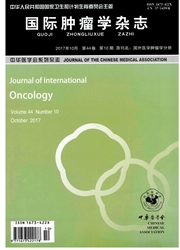

 中文摘要:
中文摘要:
目的 研究肿瘤坏死因子相关凋亡诱导配体(TRAIL)及其受体TRAIL-R2和TRAIL-R4在非小细胞肺癌(NSCLC)中的表达及其意义.方法 采用酶联免疫吸附试验(ELISA)检测79例NSCLC患者与80例正常人血清中TRAIL的表达水平,采用免疫组织化学法检测42例NSCLC组织及配对癌旁正常组织中TRAIL-R2和TRAIL-R4的表达水平.分析TRAIL、TRAIL-R2、TRAIL-R4与NSCLC患者临床病理特征的关系.结果 TRAIL在NSCLC患者血清中的表达明显低于正常人[(994.3±293.0) ng/ml∶(1 141.7 ±266.1) ng/ml],差异具有统计学意义(t=3.29,P=0.00).TRAIL的表达与NSCLC患者的临床分期(F=2.28,P=0.00)、分化程度(t=5.76,P=0.00)相关.TRAIL-R2在NSCLC组织中的阳性表达率为73.8% (31/42),明显低于正常组织中的阳性表达率100.0% (42/42)(x2=3.88,P=0.05),TRAIL-R2的表达与NSCLC患者的临床分期(x2=27.89,P=0.00)、分化程度(x2=9.50,P=0.00)相关.TRAIL-R4在NSCLC组织中的阳性表达率为81.0% (34/42),明显高于正常组织中的阳性表达率50.0%(21/42)(x2=7.34,P=0.01),TRAIL-R4的表达与NSCLC患者的临床分期(x2=17.82,P=0.00)、分化程度(x2=4.47,P=0.03)相关.在NSCLC组织中,TRAIL-R4与TRAIL-R2的表达呈负相关(r=-0.67,P=0.01).结论 在NSCLC中,TRAIL、TRAIL-R2表达减少,TRAIL-R4表达增多,三者可能促进了NSCLC的发生发展,可为NSCLC临床治疗提供靶点.
 英文摘要:
英文摘要:
Objective To investigation the expressions of tumor necrosis factor-related apoptosis-inducing ligand (TRAIL) and its receptors in non-small cell lung cancer (NSCLC) and their clinical significances.Methods The serum expression levels of TRAIL in 79 cases of NSCLC and 80 cases of normal subjects were detected by enzyme-linked immunosorbent assay (ELISA).The expressions of TRAIL-R2 and TRAIL-R4 in 42 cases of NSCLC and matched normal tissues were detected by immunohistochemistry.The relationships among TRAIL,TRAIL-R2,TRAIL-R4 and clinicopathologic features of NSCLC were analyzed.Results The expression of TRAIL in NSCLC patients was lower than that in normal human [(994.3 ±293.0)ng/ml vs.(1 141.7 ±266.1)ng/ml,t =3.29,P =0.00].The expression of TRAIL was closely correlated with clinical stage (F =2.28,P =0.00) and differentiated degree (t =5.76,P =0.00).The positive expression rate of TRAIL-R2 in NSCLC was 73.8% (31/42),significantly lower than that in the normal tissue 100.0% (42/42) (x2 =3.88,P =0.05).The expression of TRAIL-R2 was closely correlated with clinical stage (x2 =27.89,P=0.00) and differentiated degree (x:=9.50,P =0.00).The positive expression rate of TRAIL-R4 in NSCLC was 81.0% (34/42),significantly higher than that in the normal tissue 50.0% (21/42) (x2 =7.34,P =0.01).The expression of TRAIL-R4 was also closely correlated with clinical stage (x2 =17.82,P =0.00) and differentiated degree (x2 =4.47,P =0.03).There was a negative correlation between the expression of TRAIL-R2 and TRAIL-R4 in NSCLC (r =-0.67,P=0.01).Conclusion The decrease of TRAIL and TRAIL-R2 and increase of TRAIL-R4 expression may promote the occurrence and development of NSCLC,and they may provide targets for clinical treatment of NSCLC.
 同期刊论文项目
同期刊论文项目
 同项目期刊论文
同项目期刊论文
 期刊信息
期刊信息
